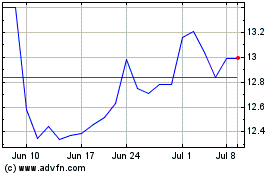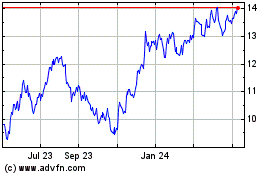KeyCorp is in advanced talks to buy First Niagara Financial
Group Inc., people familiar with the matter said, a tie-up that
would combine two regional banks at a time when such firms are
grappling with low interest rates and burgeoning regulatory
costs.
The deal could value Buffalo, N.Y.-based First Niagara at a
modest premium to its market capitalization of just under $4
billion at Wednesday's close, the people said. It would be one of
the biggest bank tie-ups of the year and would solidify 2015 as the
biggest year for bank deals since the financial crisis.
Assuming the talks don't fall apart, the deal could be announced
as soon as Friday, the people said.
Bank deals are slowly coming back as larger lenders try to
become more efficient by getting bigger and smaller banks put
themselves up for sale as their businesses struggle. But bank
mergers still face some hurdles like tough regulatory scrutiny—and
the biggest U.S. banks are effectively prohibited from doing
deals.
The likely deal price represents more of a premium over where
First Niagara shares traded in September, before reports first
surfaced that the bank might be for sale.
U.S. bank deal activity in 2015 hit the highest level since the
financial crisis on Thursday, when the announcement of New York
Community Bancorp Inc.'s purchase of Astoria Financial Corp.
brought the volume of deals in the sector to $28.4 billion for the
year, according to Dealogic. Any deal announcement for First
Niagara would push that total even higher.
New York Community on Thursday morning said it agreed to buy
Astoria in a stock-and-cash transaction valued at $2 billion. This
year's total is now the highest since 2009, when $65 billion worth
of deals were announced as financial crisis led to a number of big
mergers, according to Dealogic.
A tie-up between Cleveland-based Key and First Niagara would
bring together two mid-sized banks that operate in some similar
areas but deploy somewhat different business models. First Niagara
is a community-focused bank known for its strong deposit base,
while Key has successfully bolstered its investment-banking revenue
in recent quarters.
First Niagara, which has about 390 branches in New York,
Pennsylvania, Connecticut and Massachusetts, has grappled with
lingering issues from acquisitions of its own. Last year the lender
recorded an $800 million goodwill write-down as it reduced the
value of four acquisitions it made from 2009 to 2011. Shares
plummeted on the news at the time.
Several banks were interested in buying First Niagara, though
the number has winnowed in recent days, people familiar with the
deal discussions said. Huntington Bancshares Inc. was in advanced
deal talks as recently as Monday, but Key emerged as the most
likely suitor by mid-week, some of these people said.
Bank profits have been under pressure from low interest rates
that have lingered longer than many banks were expecting. Those
conditions also make deals attractive.
Mergers often allow banks to boost revenue faster than expenses
climb. For instance, they can help a bank spread the increasingly
expensive costs of complying with government regulations across a
broader revenue base. That has led to deals cropping up around
regulatory thresholds that kick in when banks hit a certain
size.
First Niagara has $39 billion in assets, putting it not far from
the $50 billion threshold that would make the bank a systemically
important financial institution and subject it to the Federal
Reserve's stress tests. Key, meanwhile, has nearly $95 billion in
assets, making it one of the smaller banks subject to the stress
tests.
Regulators including the Federal Reserve and the Office of the
Comptroller of the Currency have been informed about the talks, a
person familiar with the matter said. That isn't unusual, although
the scrutiny has been greater than in the past, the person
said.
Key has been trying to become more efficient and a deal for
First Niagara could help the bank do that in the long run. In the
third quarter Key's efficiency ratio, a measure of costs as a
percentage of revenue where lower is better, declined to 66.9% from
69.7% a year earlier. Chief Financial Officer Don Kimble said on
the third-quarter earnings call that Key still thinks it can get
its efficiency ratio to the low-60s range.
But Key has remained under pressure from low interest rates that
have made lending less profitable. KeyCorp's net interest margin,
an important gauge that measures how much a bank earns from the
difference between what it pays on deposits and what it takes in on
loans and investments, declined slightly in the third quarter. The
metric edged down to 2.87% from 2.88% in the second quarter and
fell from 2.96% a year earlier.
Another recent development has paved the way for more bank
deals: a prominent long-stalled bank acquisition was finally
approved by the Fed last month, and the Fed in its approval
reassured banks such a delay won't happen again.
The Fed took more than three years to approve M&T Bank
Corp.'s acquisition of Hudson City Bancorp Inc., making it the
longest delay ever for a U.S. deal valued at more than $1 billion.
The delay was caused by the Fed's concerns about M&T's internal
controls.
In its approval order, the Fed said banks with compliance issues
will be expected to withdraw their merger applications until they
are resolved. Guggenheim analyst Jaret Seiberg said in a note at
the time that the new guidance provides more clarity, "a road map
on how to ensure a deal can secure Federal Reserve approval."
Write to Rachel Louise Ensign at rachel.ensign@wsj.com, Emily
Glazer at emily.glazer@wsj.com and Dana Cimilluca at
dana.cimilluca@wsj.com
Subscribe to WSJ: http://online.wsj.com?mod=djnwires
(END) Dow Jones Newswires
October 29, 2015 13:25 ET (17:25 GMT)
Copyright (c) 2015 Dow Jones & Company, Inc.
Huntington Bancshares (NASDAQ:HBAN)
Historical Stock Chart
From Mar 2024 to Apr 2024

Huntington Bancshares (NASDAQ:HBAN)
Historical Stock Chart
From Apr 2023 to Apr 2024
